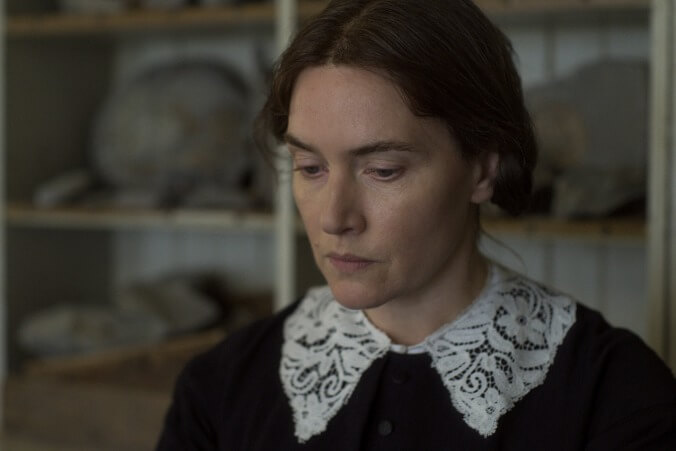Note: The writer of this review watched Ammonite on a digital screener from home. Before making the decision to see it—or any other film—in a movie theater, please consider the health risks involved. Here’s an interview on the matter with scientific experts.
Of all the beaches on all the shorelines in all the countries of the world, the English seaside has to be the most miserable. At least, that’s how it seems in
Ammonite, writer-director Francis Lee’s speculative biopic about 19th-century English paleontologist Mary Anning. In terms of sensual pleasures, this is a film that runs either burning-hot or bone-chilling cold, contrasting blue toes dipping into freezing, frothy sea water with flushed cheeks and tousled updos in post-coital repose. And were they better balanced, the interplay between these sensations might make viewers shiver in ecstasy. But while
Ammonite does evoke the feeling of blood rushing into frozen limbs after an afternoon in the wind and rain, it takes so long to warm up that it’s hard to say if that tingling is arousal or frostbite.
Strolling along the overcast shores of Lyme Regis in West Dorset, their sodden skirts dragging in the gritty sand, Mary (Kate Winslet) and her dear friend Charlotte Murchison (Saoirse Ronan) paint a somber picture of stiff-upper-lip Victorian repression—until they get to know each other a little better. That’s when the sexual tension ignites, in a pair of love scenes notable for being more explicit than what viewers have grown used to over the past couple of decades in mainstream English-language filmmaking. But Lee takes his time getting there, drawing out the characters’ passions with a cold-blooded deliberateness that matches not only the chilly seaside location but also the very English stoicism that permeates the film.
There’s no written evidence to prove that Anning, who never married or had children, had sexual relationships with women in her lifetime. But she was close with a handful of women, and same-sex “romantic friendships” were widely tolerated in upper-crust Victorian England. This was because the all-male medical establishment of the time believed that ladies of breeding barely had sexual feelings at all, let alone for other women. But when an otherwise oppressive society allowed “romantic friends” to share beds, hold hands, and write each other love poetry, who was going to tell these men otherwise? Ammonite fills in the gaps of Mary and Charlotte’s correspondence, making explicit what has long been inferred: that these bosom pals were actually devoted lovers.
But first, we slog through a series of long, gloomy silences as Mary slowly learns to tolerate Charlotte, whose husband, Roderick (James McArdle), is paying Mary to take his wife on daily walks in the restorative sea air. Charlotte, you see, is suffering from a bad case of Yellow Wallpaper-style nervous melancholia, brought on (one assumes) by a combination of tight stays, bland meals, and being trapped in a loveless marriage with an irritatingly entitled blowhard. Roderick is the walking definition of a dilettante, and his fancy has recently turned to paleontology, which is what brought him and Charlotte to Lyme Regis in winter in the first place. He soon grows bored, however, and relocates to the city, leaving his sunken-cheeked wife behind to flit about her gilded cage.
Compared to Roderick, Mary is knowledgeable and down-to-earth, a gruff, working-class spinster who wears pants when she’s out in the field and has earned the begrudging respect of her male peers. She’s also got emotional walls built up that would put a medieval keep to shame, but Charlotte has time. Nothing but time, in fact. And so, as the oppressive gray skies of midwinter gradually warm into early spring sunshine, so goes the slow melting of Mary’s wounded heart. The chemistry between the two stars is halting and tentative; Winslet plays Mary as an iceberg, all glowering disapproval and hidden depths, while Ronan’s Charlotte is a hummingbird whose heart would thrum at 100 miles an hour were you to catch her in your hands.
Lee’s approach to the material is grimly beautiful at times. Take the sound design, which contrasts the untamed noises of the natural world with the ticking of prim Victorian timepieces. Elsewhere, it’s just plain grim, and clichéd to boot. The film’s most dour memento mori come through the character of Mary’s mother, Molly (Gemma Jones), a black-clad widow who brings the old “coughing into a bloody handkerchief” method of foreshadowing into play. More novel, but equally bleak, is Molly’s collection of porcelain lambs—one for each of her children who died in infancy. (She has quite a few.)
Rainy-day atmosphere aside, Ammonite’s listlessness is largely due to the fact that, although the story is driven by Charlotte’s gradual chipping away at Mary’s emotional walls, the person hiding behind both of their facades remains elusive. The longing is palpable, but the commingling of souls abstract. And while, toward the end of the film, Ammonite takes an interesting (and possibly principled) swerve away from the dreaded “bury your gays” trope, a happy ending for Mary and Charlotte is difficult to visualize, swaddled as it is in stiff mourning crape. Mary and Charlotte’s love story is insulated from the harsher realities of their era, but unlike the idyllic seaside refuge in Céline Sciamma’s Portrait Of A Lady On Fire, you don’t get the feeling that they are building utopia together, not even in their hearts. And without this transformative element, Ammonite ends up feeling rather bloodless.
Note: This is an expanded version of the Ammonite review The A.V. Club
ran from the Toronto International Film Festival.














![HBO teases new Euphoria, Larry David, and much more in 2026 sizzle reel [Updated]](https://img.pastemagazine.com/wp-content/avuploads/2025/12/12100344/MixCollage-12-Dec-2025-09-56-AM-9137.jpg)


























